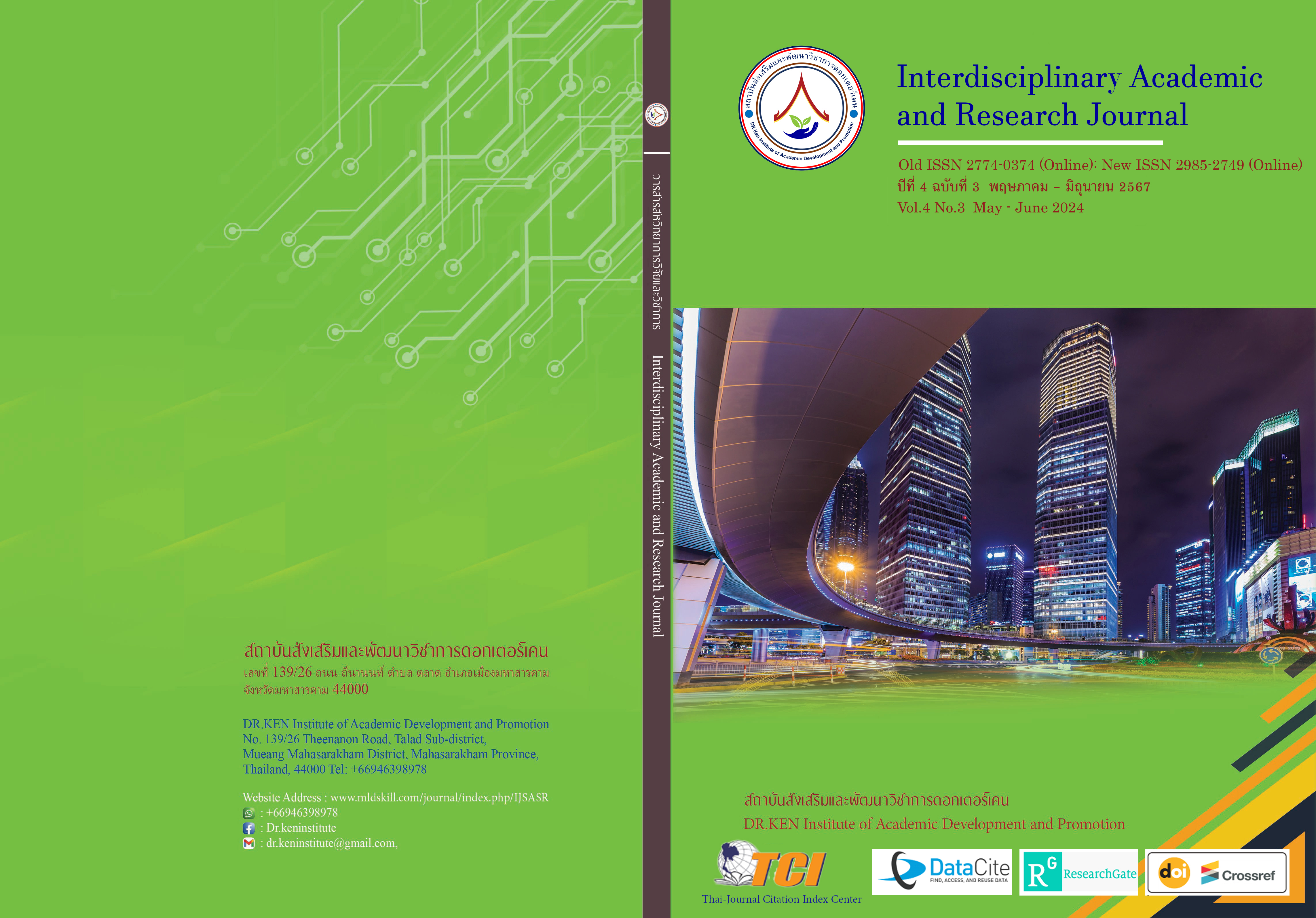Influences of Quality of Work Life and Happiness at Work on the Organizational Commitment of the Personnel of the Sub-district Administrative Organizations in Mueang Nakhon Phanom District, Nakhon Phanom Province
DOI:
https://doi.org/10.60027/iarj.2024.275592Keywords:
Quality of Working life;, Happiness at Work; , Organizational CommitmentAbstract
Background and Aims: Human resources are extremely important to an organization. Therefore, organizations try to motivate personnel through various benefits. The organization's executives therefore must find a method for making personnel commit to the organization (Commitment Management) and work with the organization to the fullest of their knowledge and abilities. Thus, the purposes of this study included the following: (1) To investigate the level of quality of work life, happiness at work, and organizational commitment of the personnel of the sub-district administrative organizations in Mueang Nakhon Phanom District, Nakhon Phanom Province, and (2) To examine the influences of the quality of work life and the happiness at work on the organizational commitment of the personnel of the sub-district administrative organizations in Mueang Nakhon Phanom District, Nakhon Phanom Province.
Methodology: Obtaining through a stratified sampling method, the sample group consisted of 247 personnel who reported to the sub-district administrative organizations in Mueang Nakhon Phanom District, Nakhon Phanom Province. A questionnaire was used as a tool to collect the data and the statistics employed for data analysis were frequency, percentage, mean, standard deviation Pearson's correlation coefficient, and Multiple Regression Analysis.
Results: (1) The quality of work life, the happiness at work and the organizational commitment of the personnel as a whole, were at a high level. (2) The quality of work-life variables altogether could be used to correctly predict the level of the organizational commitment of the personnel for 73.20 percent (R2Adj=.732) with statistical significance at the .05 level. When considering the subcomponents of the quality of work life variables, it was found that except for the opportunity to develop individual capabilities, social integration and personal rights, these aspects of the personnel’s quality of work-life contained high standardized regression coefficients for the prediction: balance between life and work, an opportunity for advancement and job security, social connection/engagement, safe and healthy work/workplace conditions, and receiving fair and adequate compensation. Moreover, the variables of happiness at work could be used jointly to accurately foretell the level of the organizational commitment of the personnel for 57.20 percent (R2Adj=.572) with statistical significance at the .01 level. When considering the sub-components of these variables, it was found that except for being accepted, these aspects of the personnel’s happiness at work had high standardized regression coefficients for the prediction: communication/relationships, success at work, and love of work.
Conclusion: According to the study, employees generally show a high degree of loyalty to the organization, job satisfaction, and quality of work life. In particular, work-life quality and happiness variables are good indicators of organizational commitment, indicating the importance of elements like job security, social engagement, work-life balance, advancement opportunities, and fair compensation in building strong organizational loyalty.
References
กัญญา บุดดาจันทร์. (2563). คุณภาพชีวิตการทำงานที่ส่งผลต่อความผูกพันต่อองค์การของบุคลากรสายสนับสนุนสังกัดโรงพยาบาลนครพนม. วิทยานิพนธ์รัฐประศาสนศาสตรมหาบัณฑิต มหาวิทยาลัยราชภัฏสกลนคร.
โกวิทย์ พวงงาม. (2554). รายงานการประเมินองค์กรปกครองส่วนท้องถิ่นที่มีความเป็นเลิศเพื่อรับรางวัลพระปกเกล้าประจำปี 2554. กรุงเทพฯ: สถาบันพระปกเกล้า.
ชฎาภรณ์ เพียยุระ. (2565). คุณภาพชีวิตในการทำงานและวัฒนธรรมองค์การที่ส่งผลต่อความผูกพันต่อองค์กรของเจ้าหน้าที่องค์กรปกครองส่วนท้องถิ่นเขตอำเภอพรรณานิคม จังหวัดสกลนคร. วิทยานิพนธ์รัฐประศาสนศาสตรมหาบัณฑิต มหาวิทยาลัยราชภัฏสกลนคร.
ชลธิชา ทองมาก. (2560). อิทธิพลของความสุขในการทำงานที่มีผลต่อความผูกพันต่อองค์การของพนักงานบริษัทกลุ่มธุรกิจโทรคมนาคมภาคตะวันออกของประเทศไทย. วารสารการจัดการ คณะวิทยาการจัดการมหาวิทยาลัยเกษตรศาสตร์, 1 (1), 57-76.
ฐิติพร มุ่งดี. (2565). ความสุขในการทำงานที่ส่งผลต่อประสิทธิผลการปฏิบัติงานของบุคลากรสังกัดกรมการปกครอง กระทรวงมหาดไทย ในเขตจังหวัดสกลนคร. วิทยานิพนธ์รัฐประศาสนศาสตรมหาบัณฑิต มหาวิทยาลัยราชภัฏสกลนคร.
ณดนย์ พุดด้วงเงิน. (2565). การสนับสนุนจากองค์การและคุณภาพชีวิตการทำงานที่ส่งผลต่อความผูกพันต่อองค์การของบุคลากรการไฟฟ้าส่วนภูมิภาคจังหวัดสกลนคร. วิทยานิพนธ์รัฐประศาสนศาสตรมหาบัณฑิต มหาวิทยาลัยราชภัฏสกลนคร.
ณัช อุษาคณารักษ์. (2554). ความผูกพันของพนักงาน. Retrieved from: http://www.hrcenter.co.th
ณัฐฐินันท์ ศรีนุกูล. (2565). แรงจูงใจในการทำงานที่ส่งผลต่อความสุขในการทำงานของบุคลากรสังกัดกระทรวงแรงงาน ในเขตภาคตะวันออกเฉียงเหนือตอนบน 2. วิทยานิพนธ์รัฐประศาสนศาสตรมหาบัณฑิต มหาวิทยาลัยราชภัฏสกลนคร.
บุญชม ศรีสะอาด. (2554). การวิจัยเบื้องต้น. พิมพ์ครั้งที่ 9. กรุงเทพฯ: สุวีริยาสาส์น.
พรรณรัตน์ โสธรประภากร. (2562). กฎหมายการปกครองส่วนท้องถิ่น. กรุงเทพฯ: นิติธรรม.
พระมหารัฐพงษ์ พรมหากุล. (2563). อิทธิพลของปัจจัยส่วนบุคคลและคุณภาพชีวิตการทำงานที่ส่งผลต่อความผูกพันต่อองค์การของบุคลากรโรงเรียนพระปริยัติธรรม แผนกสามัญศึกษากลุ่มที่ 8. วิทยานิพนธ์รัฐประศาสนศาสตรมหาบัณฑิต มหาวิทยาลัยราชภัฏสกลนคร.
วนัชพร เล่าฮะ. (2562). ความสัมพันธ์ระหว่างความสุขในการทำงานกับความผูกพันต่อองค์การของบุคลากร มหาวิทยาลัยอัสสัมชัญ. วิทยานิพนธ์บริหารธุรกิจมหาบัณฑิต มหาวิทยาลัยเกษมบัณฑิต.
สมคิด เลิศไพฑูรย์. (2558). กฎหมายการปกครองท้องถิ่น. กรุงเทพฯ: สํานักพิมพ์ คณะรัฐมนตรีและราชกิจจานุเบกษา.
สาวิณี ภูรีปติพัตร์. (2563). ความสัมพันธ์ระหว่างความสุขในการทำงานและความผูกพันต่อองค์กร ของพนักงานบริษัท ไปรษณีย์ไทย จำกัด ในพื้นที่กรุงเทพมหานคร. สารนิพนธ์บริหารธุรกิจมหาบัณฑิต มหามหาวิทยาลัยศรีนครินทรวิโรฒ.
อวัชพงษ์ มีคุณ. (2562). ความสุขในการทำงานที่มีผลต่อความผูกพันต่อองค์การของพนักงานบริษัท แลนด์ แอนด์ เฮ้าส์ จากัด (มหาชน). วิทยานิพนธ์บริหารธุรกิจมหาบัณฑิต มหาวิทยาลัยเกษมบัณฑิต.
อิสราภรณ์ รัตนคช. (2551). ความสัมพันธ์ระหว่างปัจจัยส่วนบุคคลและคุณภาพชีวิตการทำงานกับความผูกพันต่อองค์การของบุคลากรสายสนับสนุนที่ปฏิบัติงานในมหาวิทยาลัย สงขลานครินทร์ วิทยาเขตปัตตานี. ปัตตานี: กองทุนวิจัยวิทยาเขตปัตตานี มหาวิทยาลัยสงขลานครินทร์ วิทยาเขตปัตตานี.
เอื้องคำ จันทะพรม. (2564). ปัจจัยที่ส่งผลต่อความสุขในการทำงานของพนักงานองค์การบริหารส่วนจังหวัดสกลนคร. วิทยานิพนธ์รัฐประศาสนศาสตรมหาบัณฑิต มหาวิทยาลัยราชภัฏสกลนคร.
Allen, N.J., & Meyer, J.P. (1990). The measurement and antecedents of affective, continuance and normative commitment to the organization. Journal of Occupational Psychology, 63(1), 1-18.
Eisenberger, R., Fasolo, P., & Davis-LaMastro, V. (1990). Perceived organizational support and employee diligence, commitment, and innovation. Journal of Applied Psychology, 75(1), 51-59.
Krejcie, R.V., & Morgan, D.W. (1986). Determining Sample Size for Research Activities. Educational and Psychological Measurement, 30(3), 607-610
Manion, J. (2003). Joy at work: Creating a positive workplace. Journal of Nursing Administration, 33(12), 652-655.
Meyer, J.P., & Allen, N.J. (1991). A three-component conceptualization of organizational commitment. Human Resource Management Review, 1(1), 61-89.
Meyer, J.P., & Herscovitch, L. (2001). Commitment in the workplace: Toward a general model. Human Resource Management Review, 11(3), 299-326.
Meyer, J.P., Stanley, D.J., Herscovitch, L., & Topolnytsky, L. (2002). Affective, continuance, and normative commitment to the organization: A meta-analysis of antecedents, correlates, and consequences. Journal of Vocational Behavior, 61(1), 20-52.
Opener. (2003). Happiness at work. [Online]. Available: http://www.iopener.co.uk/happinessatWork
Steers, R. M. (1977). Antecedents and outcomes of organizational commitment. Administrative Science Quarterly, 22(1), 46–56.
Walton, R.E. (1975). Improving Quality of Work Life. Harvard Business Review, 15 (5), 12-16.
Downloads
Published
How to Cite
Issue
Section
License
Copyright (c) 2024 Interdisciplinary Academic and Research Journal

This work is licensed under a Creative Commons Attribution-NonCommercial-NoDerivatives 4.0 International License.
Copyright on any article in the Interdisciplinary Academic and Research Journal is retained by the author(s) under the under the Creative Commons Attribution-NonCommercial-NoDerivatives 4.0 International License. Permission to use text, content, images, etc. of publication. Any user to read, download, copy, distribute, print, search, or link to the full texts of articles, crawl them for indexing, pass them as data to software, or use them for any other lawful purpose. But do not use it for commercial use or with the intent to benefit any business.
















.png)


